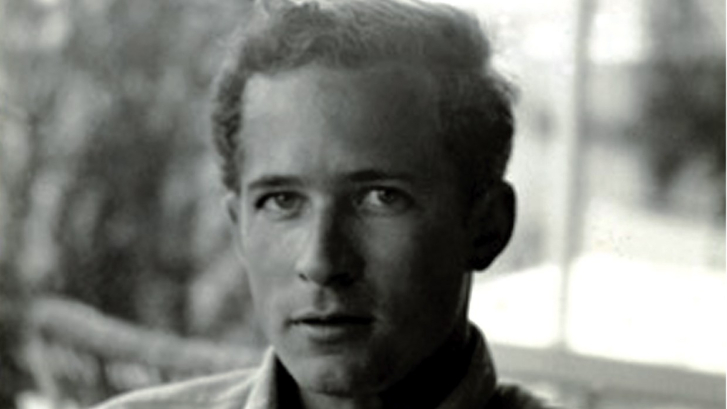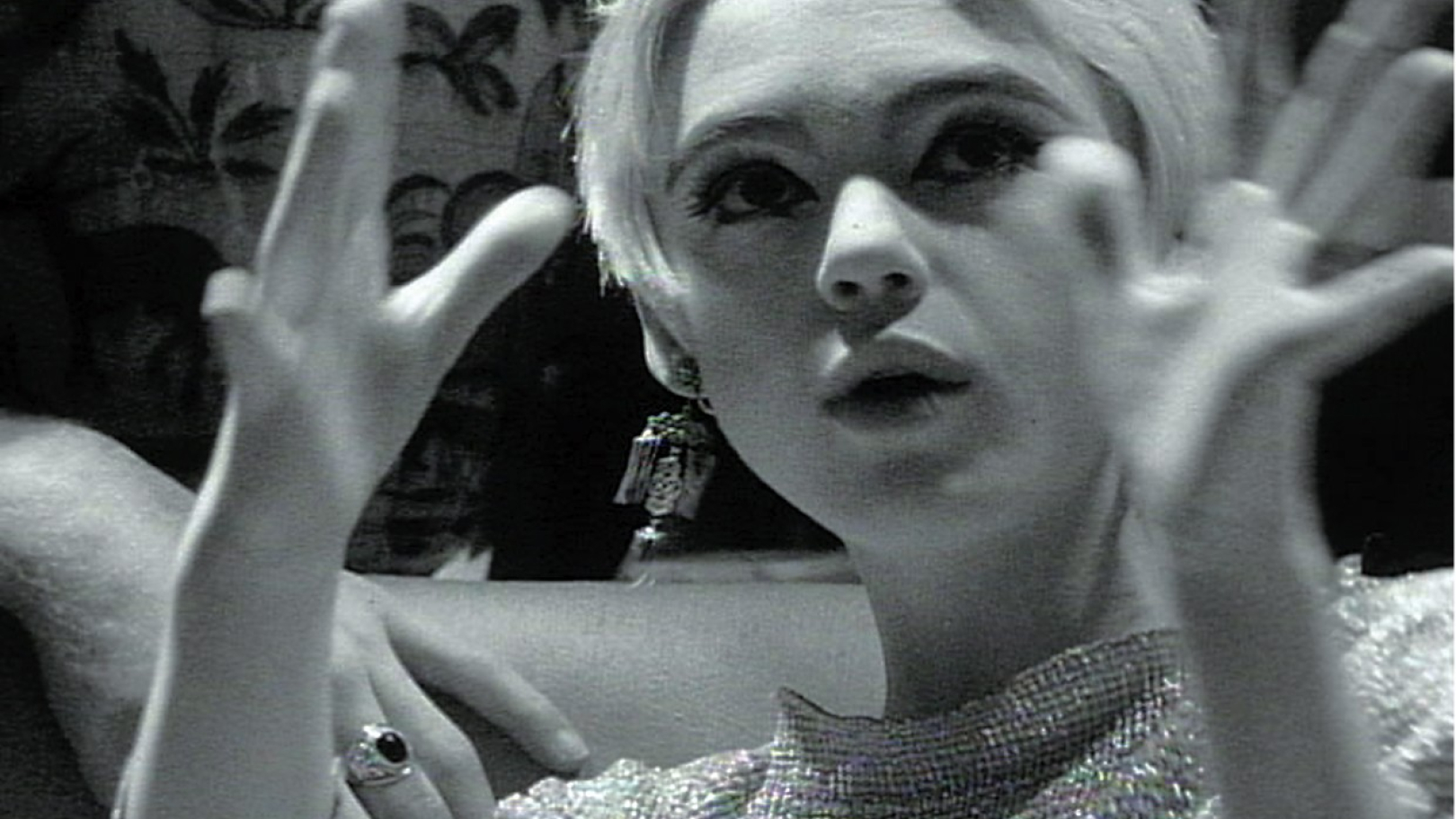A Walk into the Sea: Danny Williams and the Warhol Factory

Nadia visits her granddaughter at work - the Warhol Foundation - and says that her son Andys Lover, who had disappeared under mysterious circumstances, was and lived with him. From that moment on, two family stories became a projection screen: that of a middle-class American family and probably the most legendary of art: Warhols Factory . With the support of Callie Angell, curator of the Andy Warhol Film Project at the Whitney Museum , Esther B. Robinson , the niece of the missing Danny Williams, managed to track down a box of 16mm film material in the MoMA that was labeled with his surname. A treasure chest opens: pictures from the factory, fromVelvet Underground , familiar faces, in a never-before-seen fusion of intimacy and glamor. Robinson starts to search for clues. In conversations with contemporaries and family members, when watching the films, in research, one thing becomes particularly clear: family history is an amorphous conglomerate of memories, existing images and the distance that time has created - no different from film history. But despite the impossibility of grasping one truth, the film reveals a unique and enigmatic artist biography.
Stefanie Schulte Strathaus
Excluded from history
1965 was a year full of dynamism and intensity for Danny Williams: he gave up his studies at Harvard University against the will of his family and began a career as a filmmaker in Manhattan. First he took over the editing of two films by the brothers Albert and David Maysles . A little later he was an integral part of the 'Warhol Factory', fell in love with Andy and soon lived in an apartment that he shared with his mother. Danny Williams made more than twenty films this year and designed the groundbreaking light show for Velvet Underground / Exploding Plastic Inevitable (EPI) , The year 1966 was much more difficult for Danny.Shortly before the EPI tour through the USA began, Andy separated from him. In the three months that Danny spent on tour, his addiction to amphetamines added to the grim condition he was in anyway. After a critic in Variety described him as the “leader” of the EPI show, several Warhol Factory employees accused Danny of profiling at Warhol's expense and began to exclude him more and more from the Factory.
After the EPI tour ended in July 1966, Danny returned to his family in Massachusetts. He brought home a box of numerous diaries he wrote under the influence of amphetamines, diagram designs for light shows, and personal items and letters. So a shaving case full of drugs. After a family meal, he left the house and drove away in his mother's car. He was never seen again. Thirty-four years later, shortly after the start of the new millennium, Danny's niece, filmmaker Esther B. Robinson, was appointed program director of a foundation funded by the ' Andy Warhol Foundation for the Arts ' was carried. One summer day in 2000, Esther's grandmother Nadia visited her granddaughter at her new place of work.Nadia casually mentioned that her son, Danny Williams, had once lived in an apartment with Warhol and his mother before he disappeared under mysterious circumstances.
Stunned silence throughout the room. Then Esther was suggested to contact Callie Angell immediately. As part of the archiving of the Warhol estate in the New York Museum of Modern Art, she came across twenty silent experimental films. Andy Warhol, Edie Sedgwick were seen in these 16mm black and white films , Members of The Velvet Underground and other well-known Warhol employees. These rediscovered films were blatantly different from his own films: they followed a stylized aesthetic and bore a very personal signature - obviously they did not come from Warhol. The roles that bore the "Danny Williams" lettering were, according to Callie Angell, "absolutely exceptional".Esther thought it was possible that these films were the key to her uncle's too short life, and asked the Museum of Modern Art to return the films to her family. At the same time, she started researching her uncle's life in New York. She rarely came across her uncle's name in books about the Warhol Factory of the 1960s; the box with Danny's designs and diaries was all the more productive, which the grandmother gave her. Esther found plenty of material for creative designs and power struggles within the 'Warhol Factory', and started working on a film about the last year in her uncle's life.
In interviews with family members, she managed to uncover details of his disappearance, his complex relationship with his family and their unspoken fears.When the Museum of Modern Art finally returned Danny's films to the family, they exceeded all expectations: they literally shone and were as personal as they were insightful. A new question suddenly came up: Why was this young talent excluded from the history of the 'Warhol Factory'? Esther started to search for and interview the 'Factory' workers who were still alive. These very personal conversations shed light on the myths surrounding the legendary group and the human fragility upon which Andy Warhol's empire was built.
A WALK INTO THE SEA: DANNY WILLIAMS AND THE WARHOL FACTORY is Esther B. Robinson's attempt to shed light on the background to her uncle's disappearance and the enigma of his tragically short life. The film tells the story of this exceptionally talented young man, who was abandoned by two unstable families: his own, which was characterized above all by hierarchy and tradition, and by a legendary family of artists. With this filmic journey into the depths of family entanglements and repressed memories, we get an insight into the life of a man who was also forgotten by history.
An exciting Déjà-vu
The director about the film
There are 'missing persons' in every family: relatives who have been pushed out of family history, but whose presence is constantly noticeable in the form of photo albums, memories and grief. My grandmother never mentioned my uncle Danny, but there was a large selection of volumes on the 'Warhol Factory' on her bookshelf. When I opened books like The Andy Warhol Diaries or Edie: American Girl as a child, they opened on pages that featured Danny, or I found underlining anywhere in the text where his name was mentioned. At that time I was obsessed with these books, in which Danny's name appeared sporadically, while otherwise nothing was said about him. Why wasn't I allowed to ask questions about him? Why did my grandmother turn away every time the name Andy Warhol came up? When I got older I also recognized the other people in my uncle's photos, and I wondered why some people are famous and others are simply forgotten. Why are certain stories told and others kept secret? And who was this young man in the black and white photos? Two years after I tracked down Danny's films, the Museum of Modern Art still refused to give them back to our family; we were also not allowed to look at them. At this stage, when I was at odds with the museum's bureaucracy, I started interviewing my grandmother about the circumstances surrounding Danny's disappearance. Nobody had asked about it before. It was a kind of scary, ambiguous experience for me: did I really want to know everything about the misconduct of people I love Experienced? And did I want to publish all of these things? On the other hand, I was fascinated by numerous details: the fact that my grandmother avoided me when it came to the fact that despite her love she could never fully accept Danny; that her eyes then became restless and she started to play with the papers without realizing it. I was fascinated by all the details I learned about their love, about our family and about a bygone era. I was really overwhelmed by feelings when we finally got the films back. When I prepared the video transfer and checked whether the 40-year-old glue points would last and whether there was any damage to the material, I saw these perfectly exposed settings for the first time, in which, for example, Warhol's face glowed in a small rectangle. The result of the transfer confirmed my assumption: The perfectly preserved images took our breath away. Edie Sedgwick, for example, shines on it with an almost glowing intensity. When I saw for the first time her shiny silver hands, which move in the dark as a raft in the water, I felt a strange anxiety; I realized that these shots were almost identical to my own settings from my grandmother's hands. It was an exciting déjà-vu to share an aesthetic posture that I felt compelled to share with someone I had never known. This commonality of ours Edie Sedgwick, for example, shines on it with an almost glowing intensity. When I saw for the first time her shiny silver hands, which move in the dark as a raft in the water, I felt a strange anxiety; I realized that these shots were almost identical to my own settings from my grandmother's hands. It was an exciting déjà-vu to share an aesthetic posture that I felt compelled to share with someone I had never known. This commonality of ours Edie Sedgwick, for example, shines on it with an almost glowing intensity. When I saw for the first time her shiny silver hands, which move in the dark as a raft in the water, I felt a strange anxiety; I realized that these shots were almost identical to my own settings from my grandmother's hands. It was an exciting déjà-vu to share an aesthetic posture that I felt compelled to share with someone I had never known. This commonality of ours that these shots were almost identical to my own settings from my grandmother's hands. It was an exciting déjà-vu to share an aesthetic posture that I felt compelled to share with someone I had never known. This commonality of ours that these shots were almost identical to my own settings from my grandmother's hands. It was an exciting déjà-vu to share an aesthetic posture that I felt compelled to share with someone I had never known. This commonality of ours (Film) language, this dialogue without words that connects us with each other is of symbolic importance for this documentary. In the end, step by step, attitude by attitude, I found out what happened to this young filmmaker, my uncle Danny Williams. Esther B. Robinson
Biofilmography
Esther B. Robinson was born on September 27, 1969 in Minneapolis, Minnesota. She studied film and television production at New York University and comparative literary history at the Tisch School of Arts. She is a producer and program director. A WALK INTO THE SEA is her first film as a director.
Details
-
Länge
75 min -
Land
USA -
Vorführungsjahr
2007 -
Herstellungsjahr
2007 -
Regie
Esther B. Robinson -
Mitwirkende
Brigid Berlin, Billy Name, Gerard Malanga, Paul Morrissey, John Cale, Callie Angell, Albert Maysles, Nat Finkelstein, Julia Robinson, Nadia Williams, David Williams -
Produktionsfirma
thatgirl Media LLC., New York. -
Berlinale Sektion
Forum -
Berlinale Kategorie
Dokumentar-, Essay Film -
Teddy Award Gewinner
Best Documentary/ Essay Film
Bilder aus dem Film

Biografie Esther B. Robinson
Esther B. Robinson was born on September 27, 1969 in Minneapolis, Minnesota. She studied film and television production at New York University and comparative literary history at the Tisch School of Arts. She is a producer and program director. A WALK INTO THE SEA is her first film as a director.
Filmografie Esther B. Robinson
1998 Home Page | 2006 When I Came Home | 2012 La Camioneta: The Journey of One American School Bus